Wild Wire 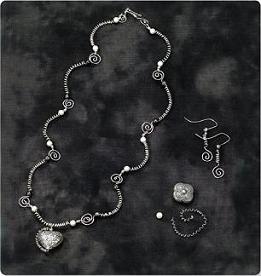
 Text, design, and compilation 2002 by Krause Publications.
Text, design, and compilation 2002 by Krause Publications.
Projects and photographic images 2002 by NSI Innovations, used with permission. All rights reserved. The NSI logo and NSI Innovations logo are the trademark of Natural Science Industries, Ltd. No portion of this publication may be reproduced or transmitted in any form or by any means, electronic or mechanical, including photocopy, recording, or any information storage and retrieval system, without permission in writing from the publisher, except by a reviewer who may quote brief passages in a critical article or review to be printed in a magazine or newspaper, or electronically transmitted on radio or television. Published by  Please call or write for our free catalog of publications. Our toll-free number to place an order or obtain a free catalog is 800-258-0929 or please use our regular business telephone 715-445-2214.
Please call or write for our free catalog of publications. Our toll-free number to place an order or obtain a free catalog is 800-258-0929 or please use our regular business telephone 715-445-2214.
Library of Congress Catalog Number 2001099546
ISBN 0-87349-457-1 eISBN: 978-1-44022-007-4 Warning: Wire has functional sharp points.
Warning: Choking hazard; small parts. The tools and materials in this book are not intended for use by children.
When cutting wire, wear safety goggles.
The Original Be-Dazzler Stud and Rhinestone Setting Machine is intended for adult use. 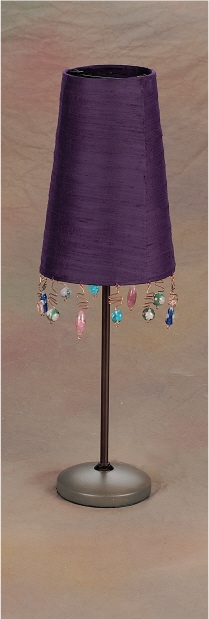 I ntroduction It wasnt but a few years ago that wire wasbarely present in the craft and art worlds; sure, itwas used to make ear wires for earrings and to linkbeads together for other jewelry applications, but notuntil recently have we begun to truly explore its uses anddiscover its awesome versatility.Consequently, it is easy to forget that wire has a long, richhistory that dates back to ancient and medieval times, when itwas used to adorn Egyptian sarcophagus and as protective chain-mailfor European knights. Over the following centuries, it was usedas personal adornment, as seen in the amazing jewelry from such far-offlands as Morocco, and utilitarian items, like rug beaters and baskets.Throughout the ages, wire has proven to be an infinite source ofwonder, and this continues to be true even today as we learn how toshape, coil, and form it into nearly any configuration imaginable. Thisbook aims to give you the basic techniques for starting your own journeyof discovery with wire.
I ntroduction It wasnt but a few years ago that wire wasbarely present in the craft and art worlds; sure, itwas used to make ear wires for earrings and to linkbeads together for other jewelry applications, but notuntil recently have we begun to truly explore its uses anddiscover its awesome versatility.Consequently, it is easy to forget that wire has a long, richhistory that dates back to ancient and medieval times, when itwas used to adorn Egyptian sarcophagus and as protective chain-mailfor European knights. Over the following centuries, it was usedas personal adornment, as seen in the amazing jewelry from such far-offlands as Morocco, and utilitarian items, like rug beaters and baskets.Throughout the ages, wire has proven to be an infinite source ofwonder, and this continues to be true even today as we learn how toshape, coil, and form it into nearly any configuration imaginable. Thisbook aims to give you the basic techniques for starting your own journeyof discovery with wire.
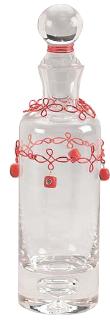 Fleur de lis Bottle.
Fleur de lis Bottle.
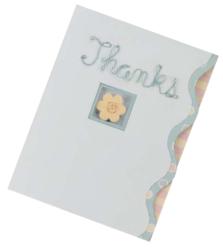 Thanks a Whole Bunch Card.
Thanks a Whole Bunch Card.
 Thanks a Whole Bunch Card.
Thanks a Whole Bunch Card.
W ild Wire Supplies and Basic Techniques Wire is one of the most versatile art and craft mediums currently available. With a few turns of a pliers, or a wrap on a jig, you can make an incredible array of jewelry, home dcor, and paper projects, ranging in style from whimsical to sophisticated. Before starting any of the projects in this book, please take the time to review the information on the following pages; not only will you get an introduction to wire and the vast selection of tools you can use to create with it, but you will also learn the basic techniques needed to successfully complete all of the projects in this book. Even if you have worked with wire before, it never hurts to brush up on the basics! S upplies  The basic supplies, materials, and tools needed to create with wire are widely available. Dont be tempted to walk into your hardware store and pick up wire and pliers; make sure you work with tools and supplies that are specifically designed for use in the craft and art worlds! A standard pliers may have grooves on the tips that will mar and mark your wire, and more industrial wires may be too difficult to work with or have coatings on them that are not satisfactory for a projects end use. Wire
The basic supplies, materials, and tools needed to create with wire are widely available. Dont be tempted to walk into your hardware store and pick up wire and pliers; make sure you work with tools and supplies that are specifically designed for use in the craft and art worlds! A standard pliers may have grooves on the tips that will mar and mark your wire, and more industrial wires may be too difficult to work with or have coatings on them that are not satisfactory for a projects end use. Wire 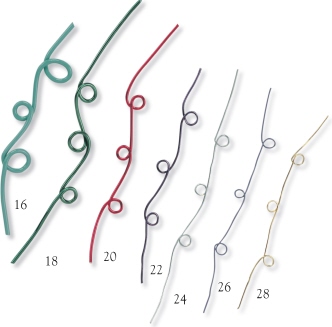 Wire in various gauges, from the heavy 16 gauge to the thin 28.
Wire in various gauges, from the heavy 16 gauge to the thin 28.
Craft wire is available in various colors and weights. The higher the gauge number, the thinner the wire. For the projects in this book, we recommend a wire that falls between 16 gauge and 22 gauge, although wire is available through the very thin 28 gauge. Practice with a few different gauges and see which works best for you for your particular project. Pliers  Round Nose Pliers.
Round Nose Pliers. 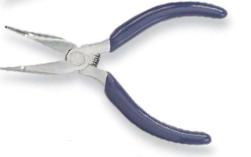 Bent Chain Nose Pliers.
Bent Chain Nose Pliers.  Nylon Jaw Pliers. Round Nose Pliers are the most basic tool in wire craft. Round Nose Pliers are the most basic tool in wire craft.
Nylon Jaw Pliers. Round Nose Pliers are the most basic tool in wire craft. Round Nose Pliers are the most basic tool in wire craft.
The nose of these pliers is made up of two tapered round metal tips that grasp and bend the wire. As you squeeze the handles together, you close the gap between the tips of the nose. Many round nose pliers also have a wire cutter, found just under the nose. To use the wire cutter, spread the handles open and slip the wire inside the cutter. Squeeze the handles together to cut. Flat Nose Pliers have angular tips. Flat Nose Pliers have angular tips.
This type of pliers can be used to create sharp angles in the wire as well as grip and bend it. Nylon Jaw Pliers are great for smoothing out wire. If the wire you are using gets little bends or kinks in it, place the bent part of the wire between the jaws of these pliers and press down to straighten it out. Because of the nylon coating, these pliers will not scratch or damage the wire. Other Tools and Supplies 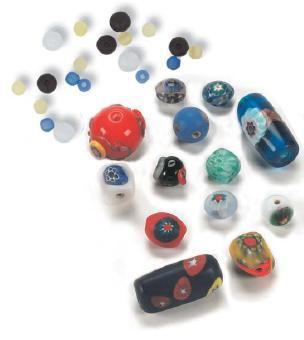 Assorted Glass and Frosted Beads. Beads, both glass and frosted, add a touch of elegance to your wire creations. Beads, both glass and frosted, add a touch of elegance to your wire creations.
Assorted Glass and Frosted Beads. Beads, both glass and frosted, add a touch of elegance to your wire creations. Beads, both glass and frosted, add a touch of elegance to your wire creations.
You can add these beads to coiled wire beads, or you can simply string them onto wire. Files are used to smooth out the tip of the wire if it is sharp. 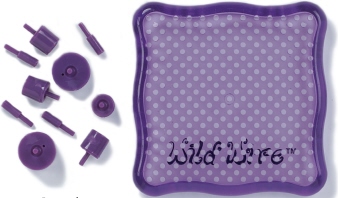
Next page


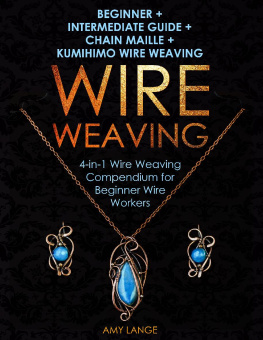



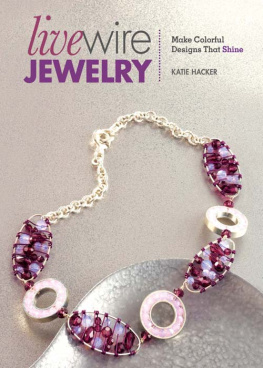
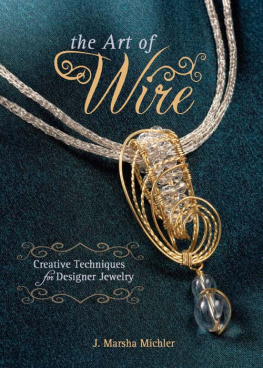
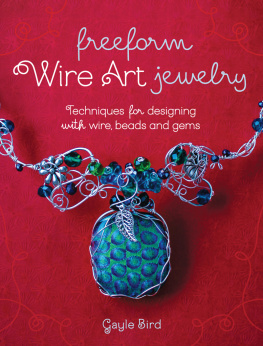
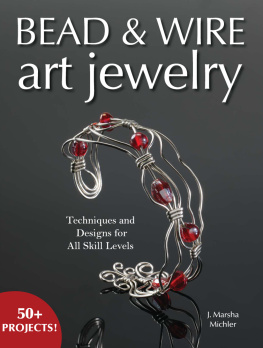
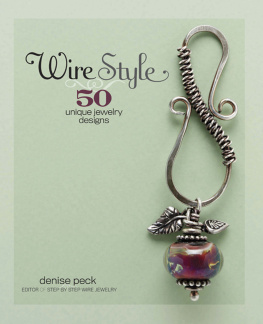
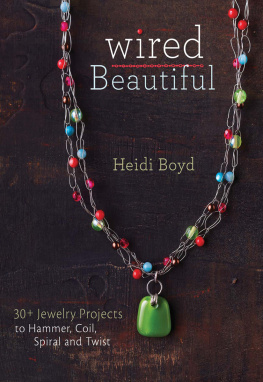

 Text, design, and compilation 2002 by Krause Publications.
Text, design, and compilation 2002 by Krause Publications. Please call or write for our free catalog of publications. Our toll-free number to place an order or obtain a free catalog is 800-258-0929 or please use our regular business telephone 715-445-2214.
Please call or write for our free catalog of publications. Our toll-free number to place an order or obtain a free catalog is 800-258-0929 or please use our regular business telephone 715-445-2214. I ntroduction It wasnt but a few years ago that wire wasbarely present in the craft and art worlds; sure, itwas used to make ear wires for earrings and to linkbeads together for other jewelry applications, but notuntil recently have we begun to truly explore its uses anddiscover its awesome versatility.Consequently, it is easy to forget that wire has a long, richhistory that dates back to ancient and medieval times, when itwas used to adorn Egyptian sarcophagus and as protective chain-mailfor European knights. Over the following centuries, it was usedas personal adornment, as seen in the amazing jewelry from such far-offlands as Morocco, and utilitarian items, like rug beaters and baskets.Throughout the ages, wire has proven to be an infinite source ofwonder, and this continues to be true even today as we learn how toshape, coil, and form it into nearly any configuration imaginable. Thisbook aims to give you the basic techniques for starting your own journeyof discovery with wire.
I ntroduction It wasnt but a few years ago that wire wasbarely present in the craft and art worlds; sure, itwas used to make ear wires for earrings and to linkbeads together for other jewelry applications, but notuntil recently have we begun to truly explore its uses anddiscover its awesome versatility.Consequently, it is easy to forget that wire has a long, richhistory that dates back to ancient and medieval times, when itwas used to adorn Egyptian sarcophagus and as protective chain-mailfor European knights. Over the following centuries, it was usedas personal adornment, as seen in the amazing jewelry from such far-offlands as Morocco, and utilitarian items, like rug beaters and baskets.Throughout the ages, wire has proven to be an infinite source ofwonder, and this continues to be true even today as we learn how toshape, coil, and form it into nearly any configuration imaginable. Thisbook aims to give you the basic techniques for starting your own journeyof discovery with wire. Fleur de lis Bottle.
Fleur de lis Bottle. Thanks a Whole Bunch Card.
Thanks a Whole Bunch Card. The basic supplies, materials, and tools needed to create with wire are widely available. Dont be tempted to walk into your hardware store and pick up wire and pliers; make sure you work with tools and supplies that are specifically designed for use in the craft and art worlds! A standard pliers may have grooves on the tips that will mar and mark your wire, and more industrial wires may be too difficult to work with or have coatings on them that are not satisfactory for a projects end use. Wire
The basic supplies, materials, and tools needed to create with wire are widely available. Dont be tempted to walk into your hardware store and pick up wire and pliers; make sure you work with tools and supplies that are specifically designed for use in the craft and art worlds! A standard pliers may have grooves on the tips that will mar and mark your wire, and more industrial wires may be too difficult to work with or have coatings on them that are not satisfactory for a projects end use. Wire  Wire in various gauges, from the heavy 16 gauge to the thin 28.
Wire in various gauges, from the heavy 16 gauge to the thin 28. Round Nose Pliers.
Round Nose Pliers.  Bent Chain Nose Pliers.
Bent Chain Nose Pliers.  Nylon Jaw Pliers. Round Nose Pliers are the most basic tool in wire craft. Round Nose Pliers are the most basic tool in wire craft.
Nylon Jaw Pliers. Round Nose Pliers are the most basic tool in wire craft. Round Nose Pliers are the most basic tool in wire craft. Assorted Glass and Frosted Beads. Beads, both glass and frosted, add a touch of elegance to your wire creations. Beads, both glass and frosted, add a touch of elegance to your wire creations.
Assorted Glass and Frosted Beads. Beads, both glass and frosted, add a touch of elegance to your wire creations. Beads, both glass and frosted, add a touch of elegance to your wire creations.